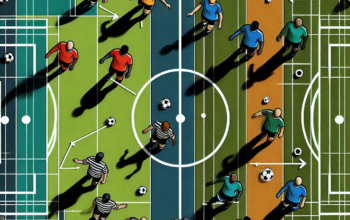The Impact of Injuries on Projected Soccer Scores
In the dynamic world of soccer, injuries play a pivotal role in shaping the performance of teams and directly influence projected scores. As the 2025 season unfolds, the significance of player fitness cannot be understated, impacting everything from tactical decisions to betting odds. Whether it’s a star forward missing a key match or a critical midfielder nursing a lingering injury, the ramifications are far-reaching. This article delves into the intricate relationship between injuries and projected soccer scores, offering insights that can help fans, analysts, and bettors understand the complexities of the game.
The Role of Key Players in Soccer Dynamics
In soccer, the performance of key players can dramatically sway the outcome of a match. When a team’s key player, such as a star striker or a commanding goalkeeper, sustains an injury, the team’s overall effectiveness often diminishes. For example, in the 2025 Premier League season, the absence of a prolific goal-scorer can reduce a club’s attacking threat, leading to fewer goals and significantly impacting projected scores. Analysts often study player contributions, examining statistics like goals, assists, and clean sheets, to assess the potential fallout of injuries.
The loss of a key player doesn’t just affect their direct contributions but also alters the dynamics of the entire squad. Teams may need to modify their playing style or formation, which can create further uncertainty in projected scores. A squad that relies heavily on a specific formation that accommodates a key player’s skills may struggle to adjust, potentially leading to more conservative tactics. Consequently, the absence of influential players can lead to less offensive play, resulting in lower expected goals (xG) for the team, thus influencing the predicted outcome of matches.
Understanding Injury Reports and Their Implications
In 2025, the accessibility and immediacy of injury reports have become crucial for fans and analysts who wish to forecast match outcomes accurately. Detailed reports provide not only the nature and severity of injuries but also expected recovery times and effects on player performance post-injury. Teams often release information about player fitness, which can drastically change betting lines and projected scores. For example, a last-minute injury to a key player can cause odds to shift significantly just hours before kickoff.
Furthermore, the implications extend beyond just one game. A player’s absence might influence the entire season’s performance as teams adapt and potentially struggle without their star. Coaches may implement alternative training regimens or recruit players from lower divisions, but these adjustments can take time to integrate properly into the team’s play, affecting scores in the long term. Monitoring injury reports and assessing their implications are vital for anyone interested in making educated predictions about a team’s future performance.
The Statistical Analysis of Injuries on Soccer Performance
Analyzing how injuries impact projected soccer scores is essential for understanding trends and forming predictions. The use of statistical models has become increasingly sophisticated, enabling analysts to quantify the effect of injuries on team performance. Machine learning algorithms can now incorporate various factors—such as the type of injury, recovery time, and player statistics—to generate accurate forecasts. In the 2025 season, data on injuries can help create predictive models that consider the player’s historical performance data, contributing to more accurate projected scores.
Moreover, teams and analysts are beginning to understand the injury-prone nature of certain athletes. For example, players with a history of soft tissue injuries may face challenges in maintaining consistent performance levels, affecting team projections. Teams may employ sports scientists and physiologists to monitor players’ health proactively, which influences decisions about rotations and game strategies closely linked to projected scores. Consequently, as the understanding of injuries evolves, teams that utilize data effectively gain a competitive advantage, leading to more accurate expectations in matches.
In addition to individual player analysis, the collective impact of injuries on team dynamics must not be overlooked. When multiple players are injured, the ripple effects can cause strategic challenges that can compromise a team’s cohesion. A collection of absentees may lead to inexperienced players taking critical roles, which could lower the overall skill level on the pitch. This diluted talent pool results in lower collective performance and, as a consequence, affects match scores gravely.
The Psychological Impact of Injuries on Teams
The mental and emotional implications of injuries on a soccer team are significant and can often override physical limitations. The absence of key players due to injury can lead to a loss of confidence and morale within the remaining squad members. For instance, many players may feel the pressure to compensate for missing talent, which can skew their performance and impact projected results. In 2025, the emphasis on sports psychology has increased, and mental resilience training has gained popularity in professional soccer to mitigate these challenges.
Additionally, the psychological burden can manifest in various ways, including anxiety and stress among players and even coaching staff. A team facing a string of injuries may experience a shift in dynamics, leading to a focus on avoidance rather than attacking play, which can stifle creativity and offensive output. Match projections, therefore, must account for these psychological factors, alongside strategic changes due to roster adjustments following injuries.
Understanding how a team’s mentality responds to injury challenges can offer deeper insights into projected scores. Teams that effectively rally around the loss of a key player, embracing a “next man up” mentality, often perform unexpectedly well. In contrast, teams mired in negative mental spirals due to injuries may dramatically underperform relative to expectations, resulting in missed opportunities and lower scores.
Injuries’ Repercussions on Betting and Fantasy Sports
In the current realm of betting and fantasy sports, the impact of injuries on projected soccer scores cannot be underestimated. Bettors constantly analyze injuries to make informed wagers. In 2025, the advancements in real-time sports data have led sportsbooks to adjust odds dynamically, reacting to the latest player news. Subsequently, injury reports can lead to swift changes in betting lines as the public and analysts reevaluate a team’s potential following significant player absences.
For fantasy sports enthusiasts, injuries create a complex landscape of strategies. A manager’s success hinges on the ability to adapt their lineup based on real-time injury updates. Injuries can provide opportunities through player call-ups or benchwarmers stepping into starting roles, potentially leading to lucrative fantasy points. Consequently, understanding current injury trends is crucial for maximizing competitive advantages, whether in traditional betting or fantasy leagues.
Moreover, analyzing how teams adjust their strategies in the wake of injuries can unlock hidden insights for those engaged in predictive models and trends. Understanding these patterns allows bettors and fantasy managers alike to create informed strategies that could lead to higher returns or success in managing their teams.
Conclusion
Injuries remain an ever-present and critical factor that affects projected soccer scores in 2025. From individual player contributions to overarching team dynamics, understanding how injuries impact performance is essential for fans, analysts, and bettors. Keeping an eye on injury reports, acknowledging psychological effects, and utilizing statistical analysis can all help to form more accurate predictions. As soccer continues to evolve, the ability to effectively analyze the multifaceted repercussions of injuries will remain vital in forecasting outcomes and enhancing competitive strategies.
FAQs
What types of injuries most commonly affect soccer players?
Common injuries in soccer include hamstring strains, ankle sprains, knee ligament tears (like ACL and MCL injuries), and muscle pulls. These injuries significantly impact players’ game time and performance.
How do injuries impact betting odds for soccer matches?
Injuries can lead to swift adjustments in betting odds, as sportsbooks update lines to reflect changes in team strength due to player absences. Bettors must monitor injury news closely to make informed decisions.
Can teams recover from injuries during a season?
Yes, teams can recover, especially if they have strong depth and training facilities. Most squads adapt over time, allowing other players to step up and maintain performance levels, although the adjustment period can vary.
What role does psychology play in the aftermath of player injuries?
Psychology is crucial; teammates may experience anxiety or pressure to fill in for injured players. A positive mental attitude can boost team performance, while a negative mindset can hinder results.
How can fantasy soccer players benefit from understanding player injuries?
Fantasy players can gain a competitive edge by closely tracking injury reports. Injuries can create opportunities for bench players to excel, presenting potential value picks for fantasy lineups.






